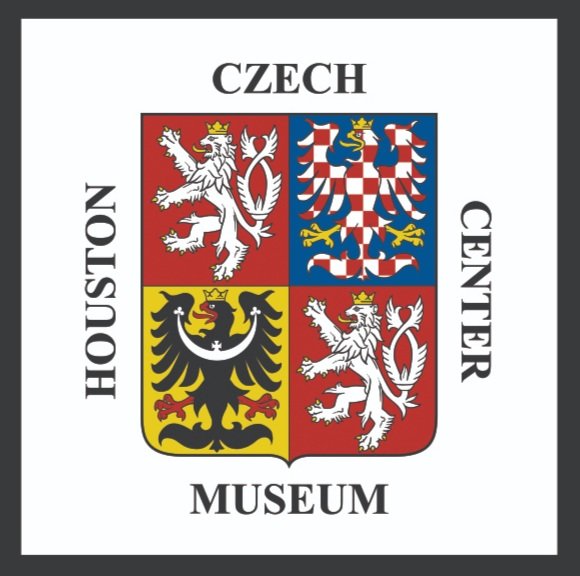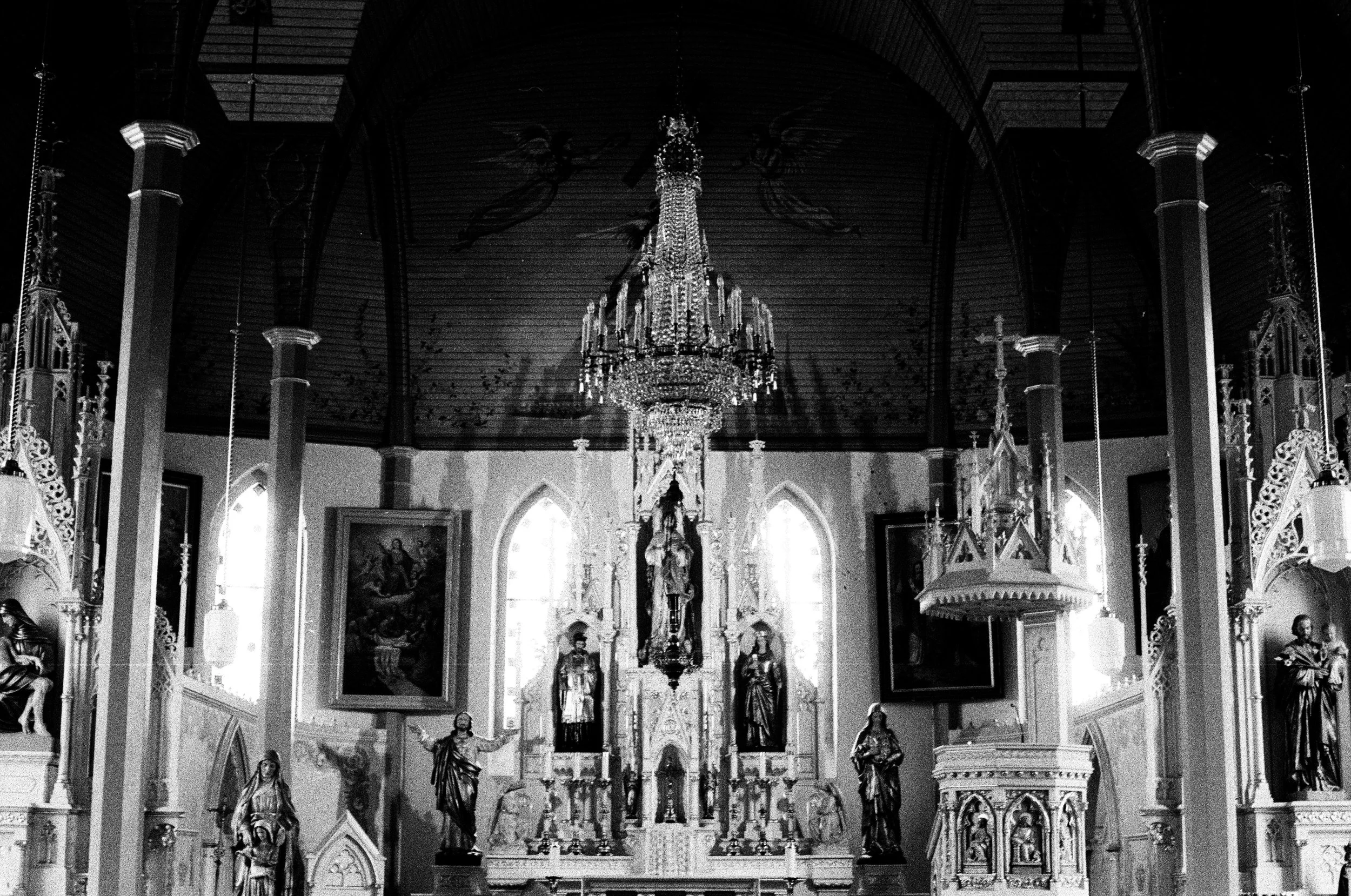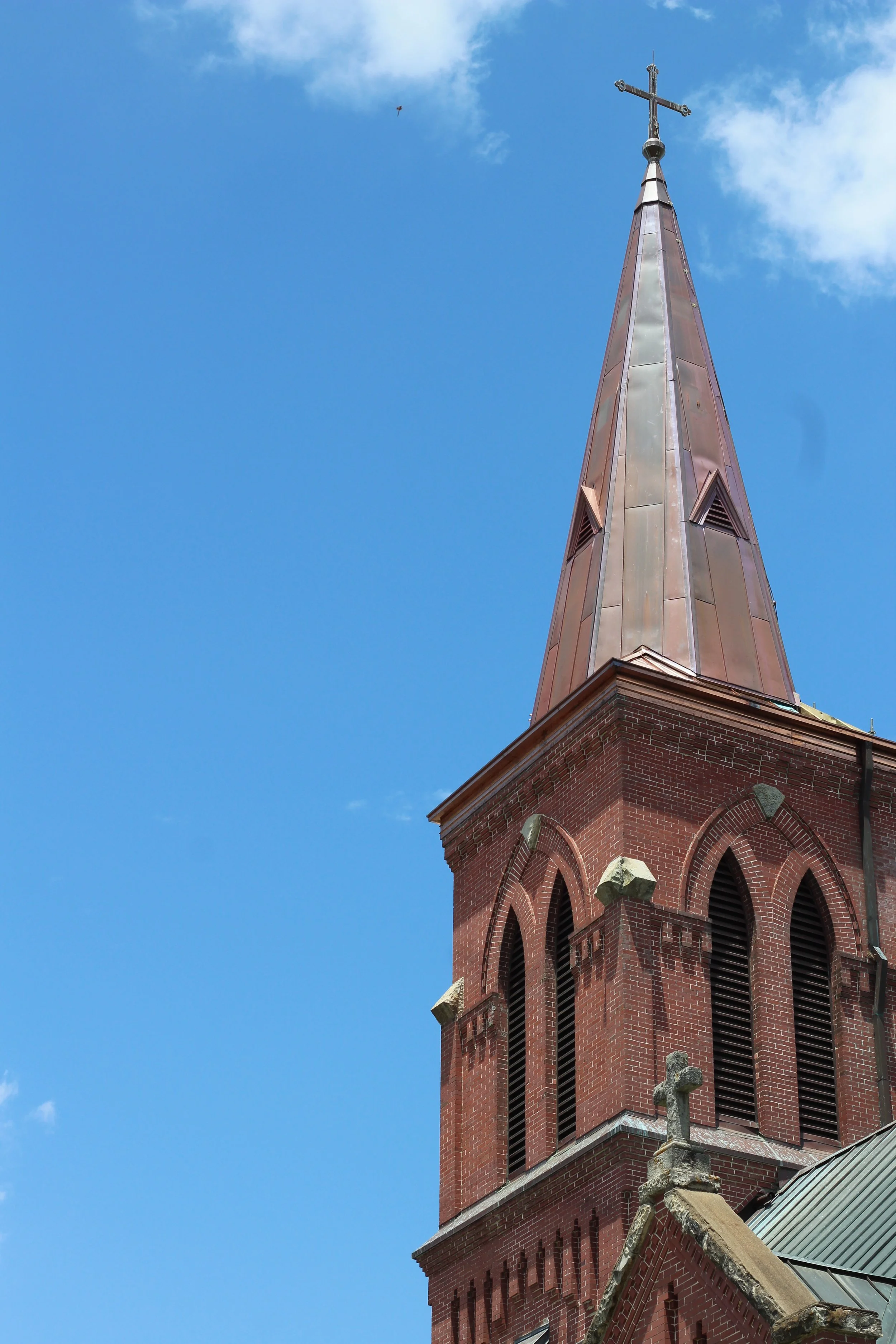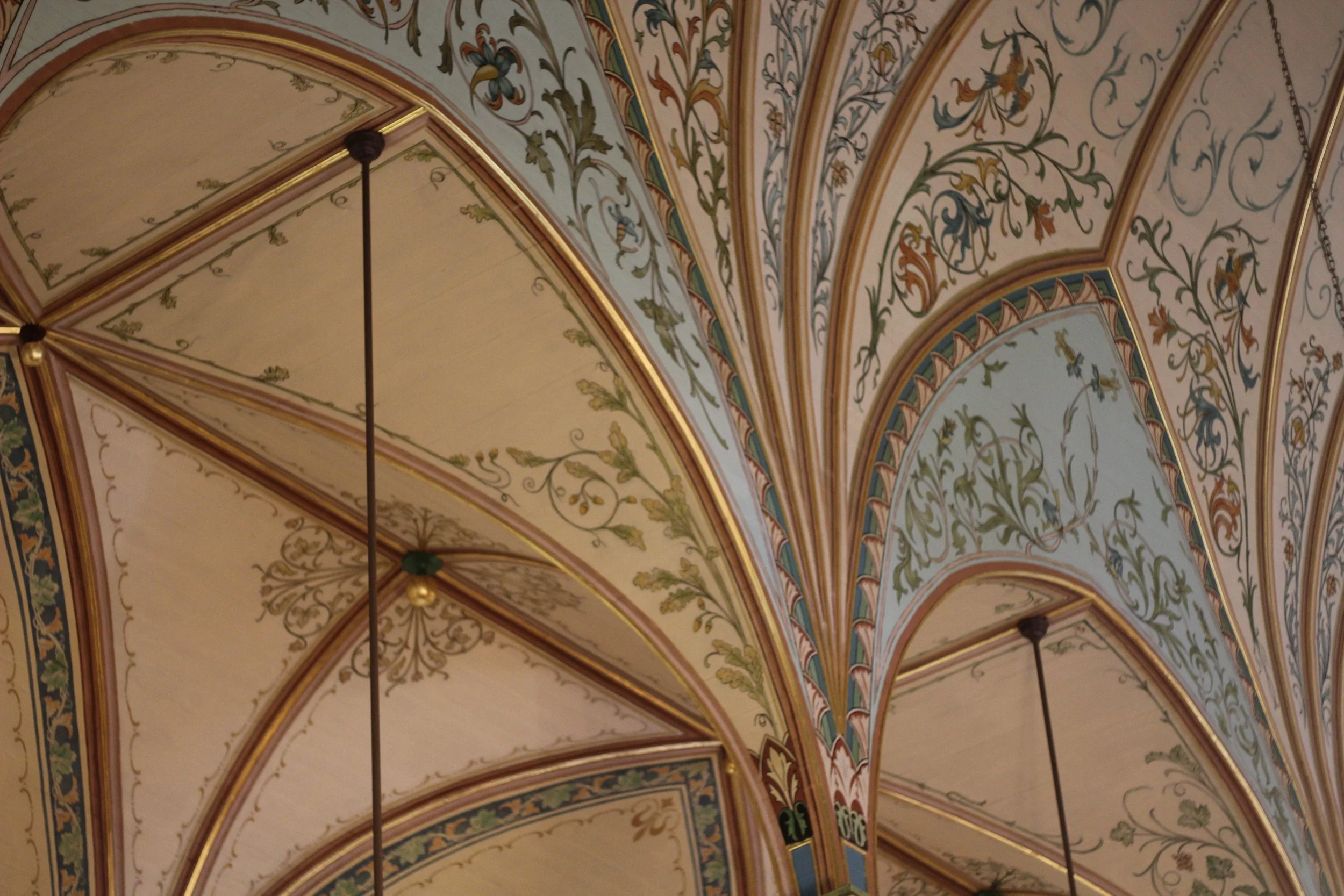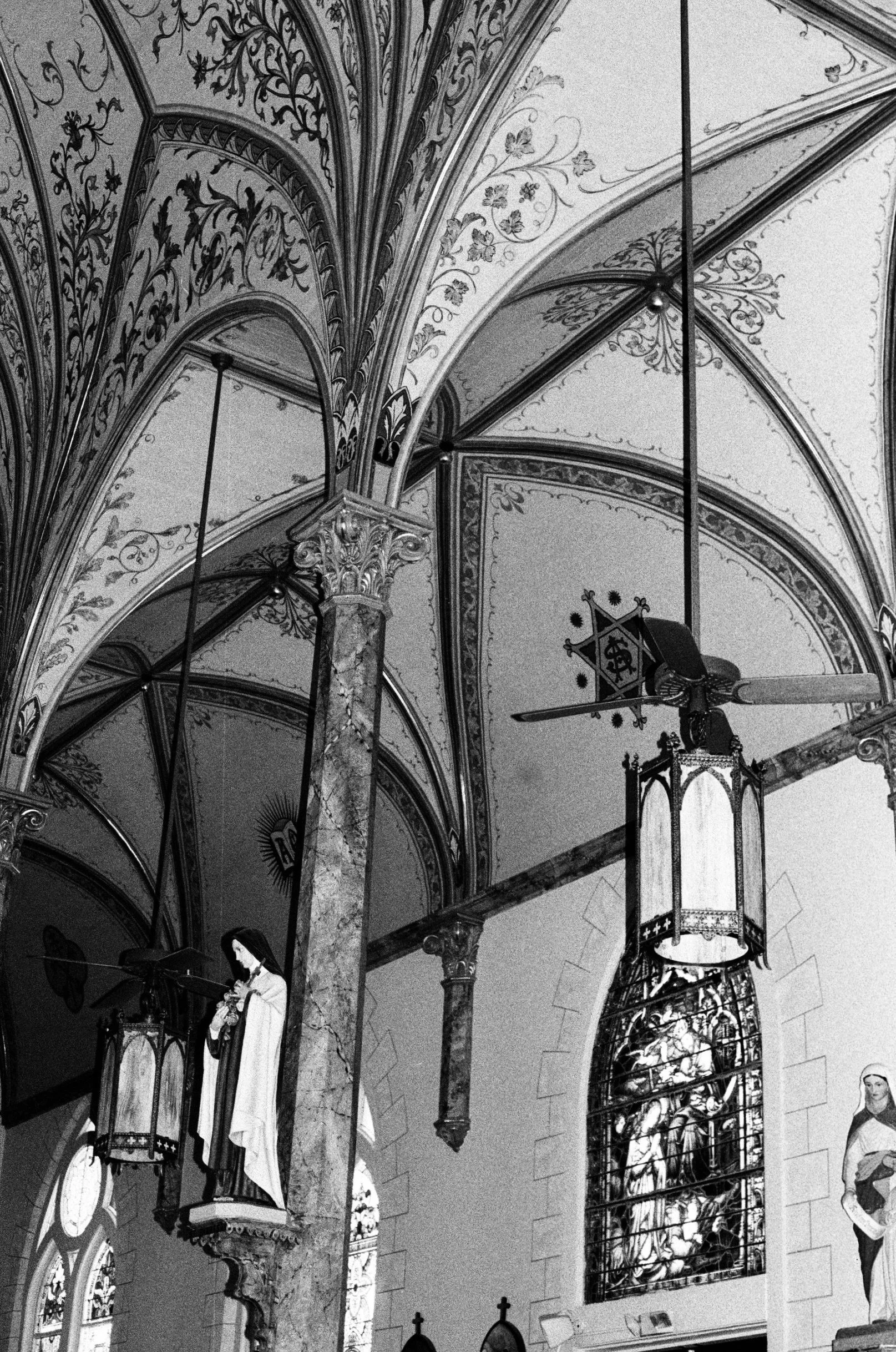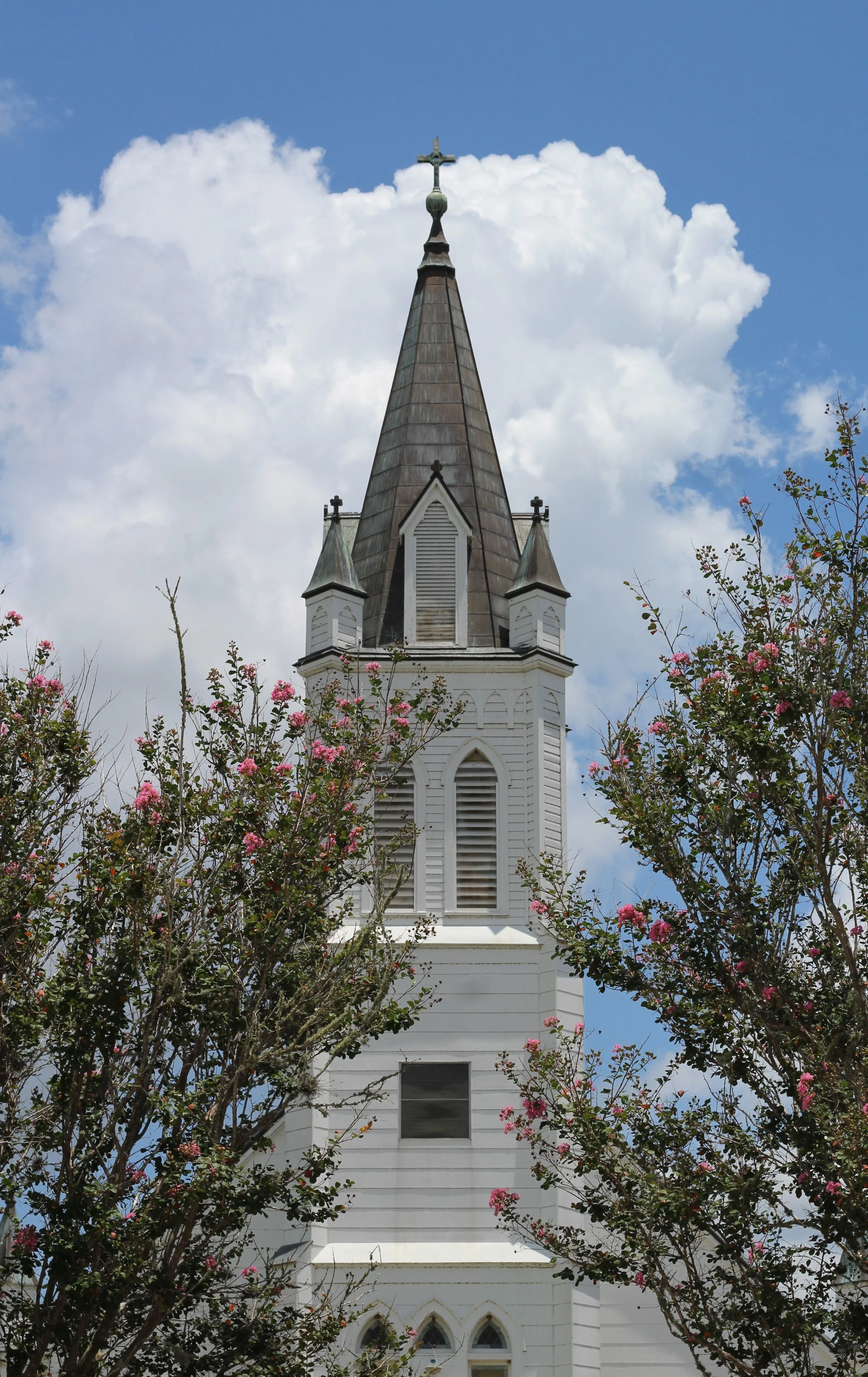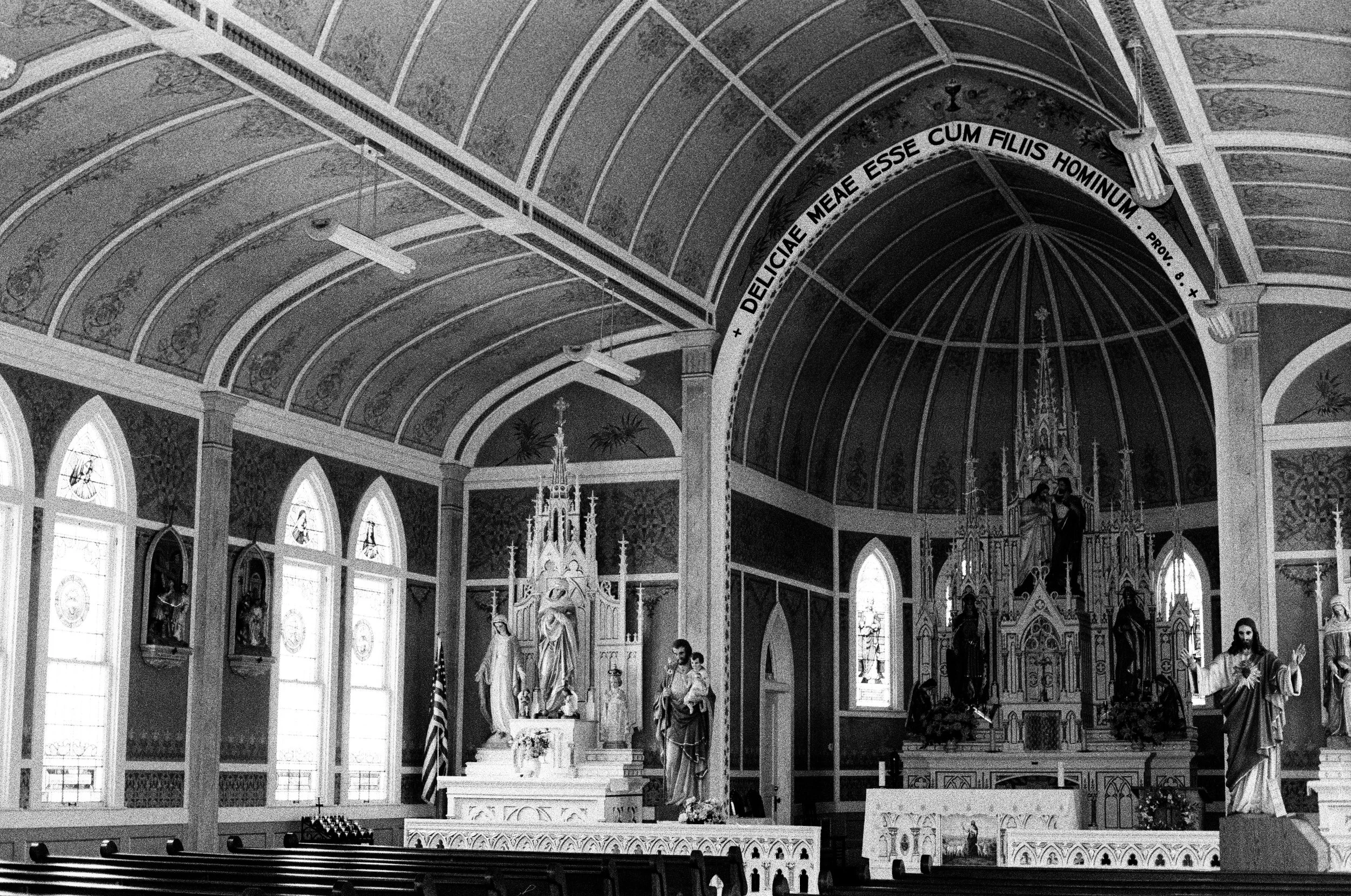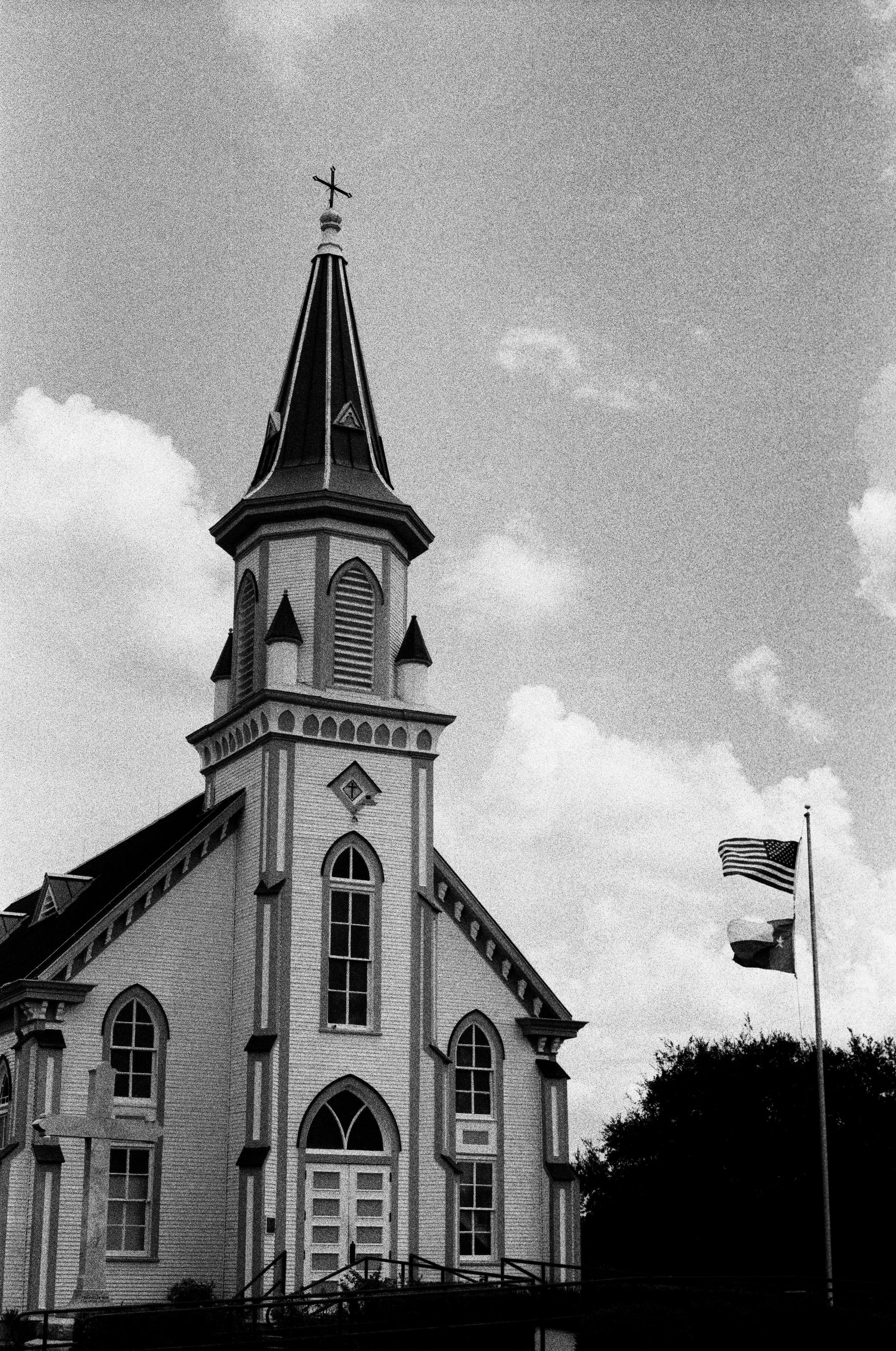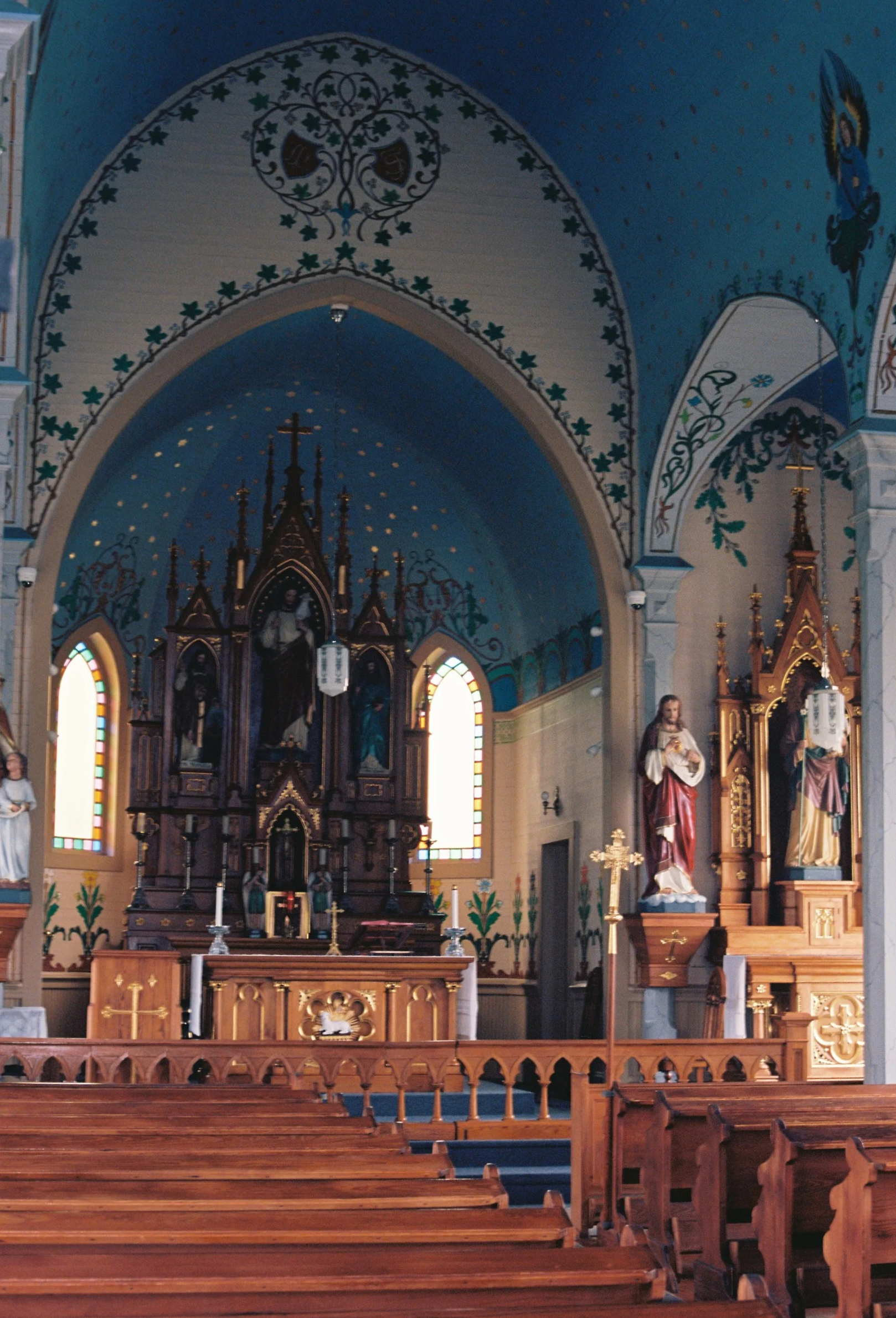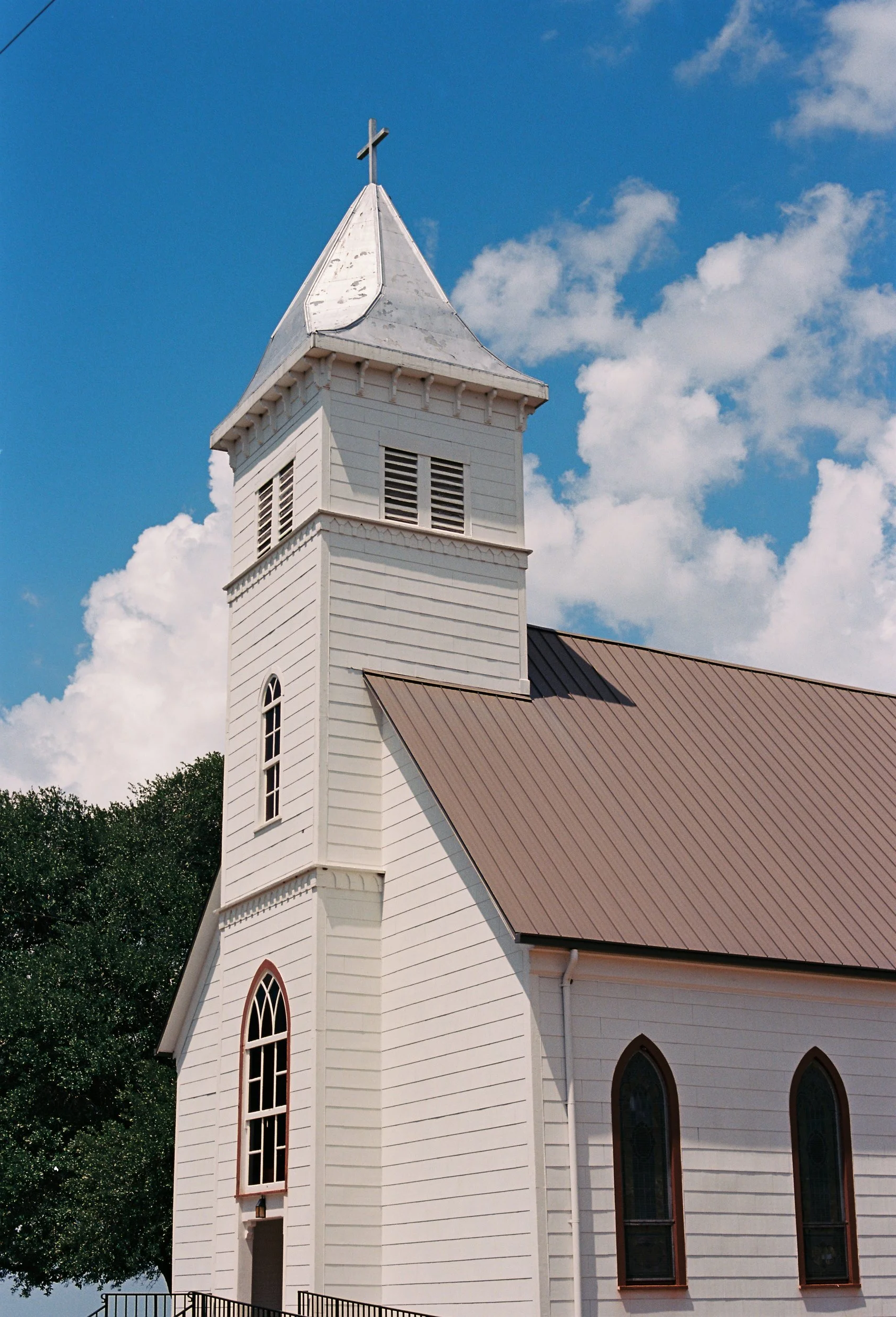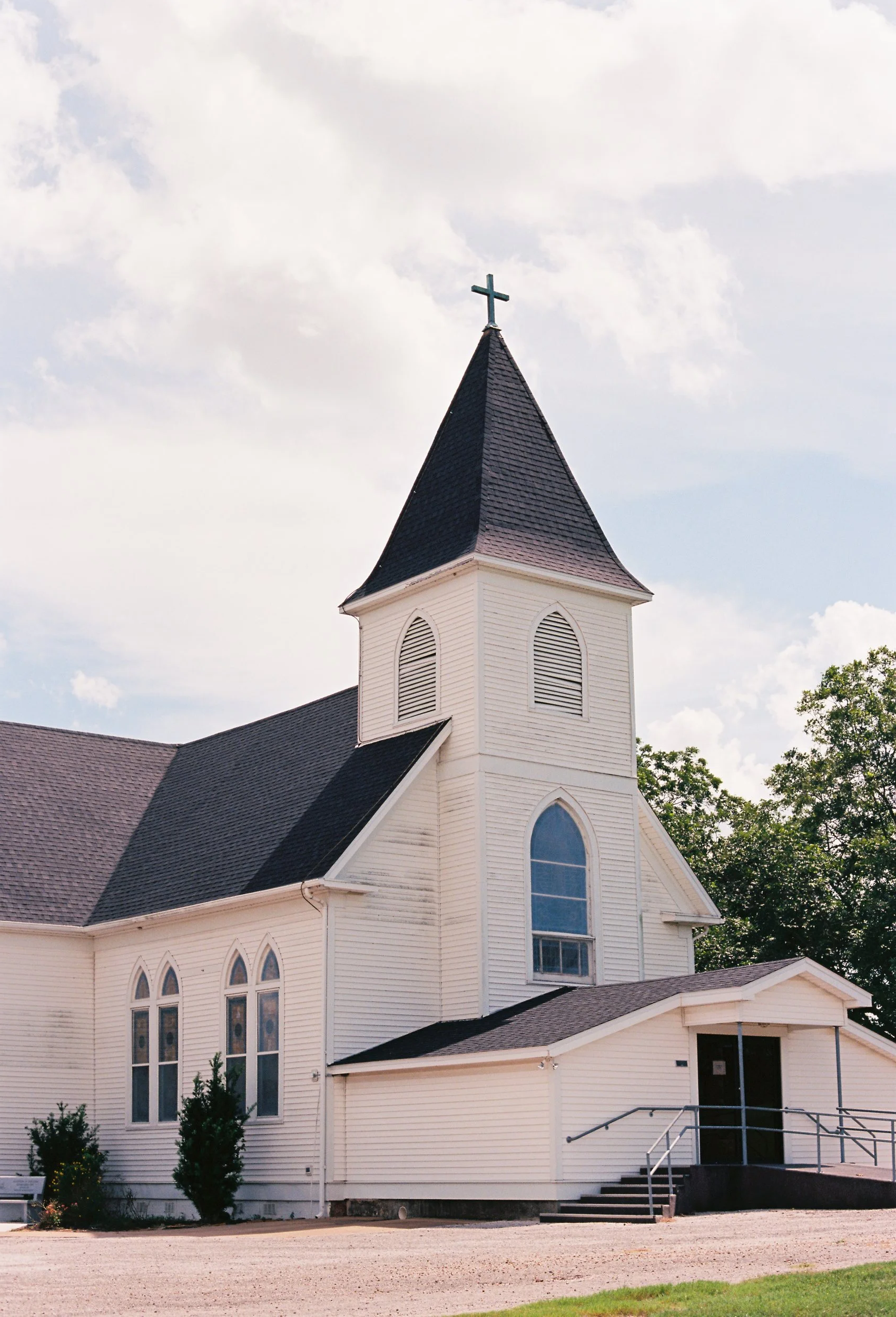Czech Painted Churches of Texas
St. Mary’s Church of the Assumption in Praha, Texas
This was the first church we visited, and it set a high bar of expectations for these painted churches. This church was by far the largest one, with the typical large outdoor hall, school, and graveyard nearby. Godfried Flurry was the architect of the current standing church, which was built in 1895. This church was the first Roman Catholic church built between San Antonio and Houston, TX. The outside of this church is unassuming, with a rectangular stuccoed stone outside. The Gothic revival style includes buttresses, windowsills of exposed stone, a square tower, an octagonal spire, a gabled roof, and carved wooden doors. The artistry of this church is something else, painted with a secret paint mixture that Flurry took to his grave that has never been repaired. The paintings are intended to resemble the Garden of Eden and feature freehand, stencil, infill, Trompe L’oeil, and marbling techniques. The ceiling has many religious motifs along the ribbed panels, such as stars, hearts, radiating yellow sunbursts, and three winged angels. There is a dedication to Praha's Czechoslovakian heritage through the feature of a main cathedral and nearby convent in Praha, which connects this Texas church back to its people’s homelands. It features many natural aspects, such as colored blossoms and rinceau and festoon patterns. The church seems to radiate around a large 19th-century chandelier made from 3000 crystals brought over from Czechoslovakia.
St. Mary Church High Hill in Schulenburg, Texas
The next church we traveled to was St. Mary Church in High Hill. This church may have been my favorite church because of the elaborate stained-glass windows. This church has a wooden interior and a brick exterior and was designed and built by Leo Dielmann and Frank Bohlmann in 1906. Ferdinand Stockert and Hermann Kern helped to retouch the paintings later in 1912. The church follows the trend of Gothic Revival style with buttresses, a polygonal apse, rectangular sacristies, a square tower, an octagonal spire, and lancet windows. The artistry of this beautiful church is surrounded by sky blue, off white, and green colors. It has many marbled wood columns, groin vaulting, diagonal ribs, and 24K gold ridge bands, creating an ornate feeling around the interior. The paintings themselves include stylized vines, clouds, and the Lamb of God flanked by angels.
St. John the Baptist Catholic Church in Ammansville, Texas
The next church was St. John the Baptist Catholic Church, which is known as the pink church. Previously two other churches occupied the site, with the first being destroyed by a hurricane and the second being burnt down; the current one was completed in 1919. This church is directly next to its graveyard and has a white wooden exterior. The interior is all a muted light pink with simpler windows and paintings than we had seen in the previous churches. The paintings include stenciling, infill, freehand, and marbling techniques that are seen in the floral patterns, draped garlands, interwoven circles, and multicolored geometric designs. Above the altar are two small cherubs flanking a chalice, palm fronds, and blossoms, with St. John featured in the altar. The Gothic Revival architecture style is seen through the polygonal apse, soaring spire, tall bell tower, corner buttresses, steep-pitched ventilation dormers, and lancet windows.
St. Cyril and Methodius Church in Dubina, Texas
The next church was St. Cyril and Methodius Church in Dubina. Again, this church was located next to a graveyard. A picture of this church was the first introduction I had to the painted churches, so it was so cool to see it in person. The golden stars across the ceiling are 6-pointed stars, with each point representing the attributes of God: power, wisdom, majesty, love, mercy, and justice. This church was whitewashed in the 1950s, but with the help of Judge Ed Janecka and Butch Koenig in 1980, the paintings were able to be recreated because of the designs Judge Janecka remembered from seeing them in his childhood as an altar boy. The original church was destroyed in 1909 by a hurricane, but the current one was designed by Leo Dielmann.
St. John the Baptist German Catholic Church in St. John, Texas
The final church we went inside of was St. John the Baptist German Catholic Church in St. John. This church was one that had not come up in my research before my trip to the churches, so I was surprised when we went inside. This was a smaller yet still beautiful pink and blue church with a large painting of St. John the Baptist baptizing Jesus above the altar. This small church was flooded with warm light from the stained glass, which spread a warm glow across the wooden benches and walls. It was on the simpler side but still had aspects of the extravagant churches, such as stained-glass windows, intricate Stations of the Cross, and a beautiful altar.
Ascension of Our Lord Catholic Church in Moravia, Texas
Ascension of Our Lord Catholic Church in Moravia is technically the last church we visited. The church was having their big annual celebration the next day, it was closed to the public. I was able to walk around the outside and see glimpses of the inside. Although I did not see much, I know the classic white wood hides inside a beautiful masterpiece of a church that hopefully one day I can see.
Art and Architecture Styles of the Churches
Many of the styles of art that are seen in the churches came out of Austria and German influences. The styles of art seen in these painted churches range from being purely religious to sometimes more decorative. Trompe L’oeil is a French term for "to deceive the eye" and works to make a 2-dimensional surface look like a 3-dimensional surface. This style wanted to create a way for paintings to exist in the same space as the viewer as illusory realism. Graining and marbling are examples of that where a surface is made to look like real wood or real marble. Stencil technique is a small-scale repeated geometric or natural pattern with borders. Freehand technique has unique individual designs. The infill technique is large repeating patterns, with a preliminary outline and then the design to fill it in with shading. These techniques are seen across the painted churches of Texas to make them as close as possible to the magnificent churches back in these people’s homelands.
The main architecture style of these painted churches is Gothic Revival architecture. This style became popular between the 1840s and 90s. It is defined by a high-pitched roof, cross gabling, pointed arch windows, stained glass, and complex shapes. These types of buildings are typically thin and delicate to let as much light in as possible. The element of light is thought to reflect the truth of God and be the closest thing to heaven on earth. Stained glass windows reflect colored light when sun hits them, creating a beautiful colorful glow around the building. This style of architecture is popular in churches, houses, and public buildings. It is associated with European ecclesiastical architecture and romantic medieval styles from the 1700s. Gothic cathedrals were common in Europe because they were linked to the power of the Medieval Catholic Church. It became popular in the Northeast United States, particularly through the architecture of Alexander Jackson Davis and his 1st American Gothic house, built in 1832. He also promoted Gothic architecture through publications, public speaking, and books. This type of architecture was chosen for the painted churches because the architecture reminded immigrants of their homelands, such as the Old New Synagogue, Stone Bell House, St. Vitus Cathedral, and Old Town Bridge Tower.
Czech Texans
Who they are
Czech immigrants had a very specific way of living, most of it being influenced by their home country. Since these immigrants were used to living on family farms, they continued this lifestyle in Texas. This has progressed to the current strong Czech communities across Texas. The social structure of these Czech communities is built around a close-knit family unit with strong attitudes towards land. These Czech Texans were self-contained economically and socially, revolving only around the cultivation of land. The Czech Texans helped establish many institutions to make the new Texas land feel like home. They created newspapers, like the Nasinec and Hospodar that have continued to be published weekly and monthly since 1993. The Vestnik and Brethren Journals have also continued to be fully published in Czech. The fact that these newspapers have continued to be published for so long attests to the strength of Czech culture. Other elements such as oral literature, traditional games and rituals, and food have also helped to keep the Czech culture strong in Texas. But many people struggle to give an exact definition of what Czech culture has become. This is because of the mixture of influences from the Czech Republic, Slovakia, Moravia, and Bohemia backgrounds. This has developed to create a language that combines Moravian, Czech, German, and English dialects. The very teaching of Czech culture and language has been established through education and schools. In each small Czech Texas town, there are schools to accompany the churches. This all has helped a new Czech culture of Czech develop in Texas.
Immigration to Texas
The first Czech immigrants came over to Texas around 1823 because of overcrowded farmland and frustrations with their country. They were influenced by liberalism ideas and the hope for national self-determination. In the end, these Czechs were attracted to Texas because of the inexpensive and highly fertile farmland Texas had to offer. The first group to come over consisted of 16 original families of poor Protestant laborers from Nepomuky and Cermna in Northeastern Bohemia and was led by Josef Silar on August 19, 1851. The journey was extremely treacherous and often resulted in half the group passing away. The journey typically went from Bohemia to Hamburg to Liverpool to New Orleans, then finally to Galveston, TX, where the families would then spread across Texas. The second group to come over was led by Josef L. Lesikar, and this group was influenced by the letters from Rev. Josef A. Bergmann. Bergmann was named the "father of Czech immigration to Texas" because of the letter he wrote to friends and family in Moravia and Bohemia about the opportunities in Texas. The long and treacherous journey across the world to get to the United States proved to be worthwhile, as these Czech immigrants are still prevalent in Texas today.
Czech Settlements in Texas
As these Czech immigrants finally arrived on Texas land in Galveston, they then dispersed to find the fertile lands they came for. Cat Springs, TX, was the usual point of dispersal for these immigrants, who then might move to Austin, Fayette, Lavaca, and Washington counties. Fayette County became the center of the Czech population in Texas and became known as the "cradle of Czech immigration in Texas." For immigrants that moved up to North Texas, they typically settled in Williamson, Bell, McLennan, Hill, Ellis, and Kaufman counties. For immigrants that stayed in South Texas, they typically settled in Burleson and Brazos counties. And immigrants that stayed along the coast settled in Wharton, Fort Bend, and Victoria counties.
Czech Texan population growth
Over time as Czechs continued to immigrate to Texas, the population increased with them. Around 1864 there were only 700 Czechs in Texas, but rapidly these numbers changed. By 1900 there were about 9,000, and by 1910 there were about 15,000. But after 1910 the population began to decrease. In 1930 there were about 14,000; in 1940 there were about 8,000. But by the 1940s there was an increase in "Foreign White Stock," which were people who spoke Czech at home; this was about 62,000 people. By the 20th century there were about 250 Czech communities in Texas. By 1990 there were about 168,000 people of Czech descent, and this number has very slowly increased to about 193,000 people of Czech descent in Texas in 2025. In more recent times an increasing number of Czech descendants have left family farms for more urban living. The first small group of around 40 people that came to Texas from Bohemia would have never expected the number of descendants that they have that spread across Texas today.
Community and Culture
To make the new foreign land these Czech immigrants were in feel more like their homeland, they established many clubs, organizations, and institutions that grew to state levels as the populations grew. Beef Club was a club that would supply fresh beef to members each week in the spring and summer. SPJST, or Slavic Benevolent Order of the State of Texas, was founded in 1897 to provide financial security and support for its members and has grown to have more than 140 lodges statewide. KJT, or the Czech Catholic Union of Texas, was founded in 1889 and provides members with life insurance, financial aid, and scholarships. Texans of Czech Ancestry was founded in the mid-1980s and has worked to celebrate the role of Czechs in Texas history. The Czech Heritage Society was founded in 1982 and by 2003 had 14 chapters across Texas. There are many Czech festivals that happen across Texas, such as Czech Fest in Rosenberg, Czhilispiel in Flatonia, West Fest in West, the National Polka Festival in Ennis, and the Strudel Bake in Shiner. These many festivals and traditions are examples of the strong existence of Czechs in Texas today. The many societies formed around Czech culture have had a long-lasting impact on Texas and display traditional Czech values on their new land.
Religion
Religion has always been central to Czech immigrant life. In the late 1800s about 90% of their homeland was Catholic, with minorities being Protestant and freethinkers. Protestant Czechs held the first Protestant service in 1855 near Fayetteville. This specific branch of Protestant religion became known as the Unity of the Brethren Church or the Hussites in Europe. This religion was resurrected and formally organized as an independent denomination in 1903 in Texas. Freethinkers were people who challenged all religious authority. This movement was prominent in the Midwest United States. Catholicism became the leading denomination in Texas. The first Catholic church was built in Ross Prairie in 1859. Czech Catholics in Texas named Honor St. Mary’s Church in Praha, TX, as their mother parish. Josef Chromcik was known as the most important pioneer as a Czech Catholic priest in Fayetteville in 1872. By 1860 the majority of Czech Texans identified themselves as Roman Catholic. By 1917 there were 68 Czech Catholic centers across Texas. Currently Czech Texans identify themselves as about 70% Roman Catholic, 25% Protestant, and 5% liberal and freethinkers. There are 101 Catholic churches in Texas and 61 miscellaneous churches, congregations, and missions. The influence of Catholicism for Czech Texans originated from Saints Cyril and Methodius's missionary work in Prague as Christians in the 9th century; from there Christianity and Catholicism became dominant and spread across the area. As of today, Czechs often define themselves as secular, living in a post-communist, post-Christian nation. From a 2011 census, 79% of Czechs profess no religious belief, while the rest are made up of Roman Catholics and Protestants. Despite the changes in religion around Europe, religion has always been a main element in Czech existence, and particularly in Texas, it helped to preserve Czech culture over the years.
Local Czech Texans - Personal Stories
I got the chance to talk with a couple Czech Texans to give me more insight into how their life looks like as active participants in their Czech Texan communities. Carol helped to define Czech Texans as a group that is hesitant to change from their deep traditions. She explained how deep the church and religion are into these small towns, with the church acting as the community center with their frequent festivals and feast days. She introduced me to the strudel bake in Shiner, Texas, which is a large fundraiser for the school where anyone can come to learn how to make strudel. She talked of the pockets of Czech people across Texas, including a Czech mass held in Katy, Texas. She grew up in El Campo, Texas, and it was surprising to learn from her that even that small town had Czech influences, such as the high school fight song being a polka song. I also talked to Gary, who is a part of the Schulz family from Moravia who settled in Schulenburg, Texas, long ago. Gary helped describe to me the reverent and beautiful churches of Schulenburg. He talked about the differences in Czech masses, sometimes including Czech hymns and unique practices. He emphasized the fact that each church has its own halls, sometimes a graveyard and a school, especially going into how tight knit the community is. The gatherings at the halls bring families together and are sustained by volunteers who care deeply because they grew up around the church. He explained that the Czech Texans have stayed together to continue to cultivate religion, polka music, dances, and customs.
This online exhibition was written and photographed by Sealy Teheng. She is a student at The University of Texas at Austin pursing a degree in Studio Art and Arts Management and Administration. She is a rising junior and loves photography! She is excited to hopefully work with more photography projects like this one and loves to learn about new cultures!
